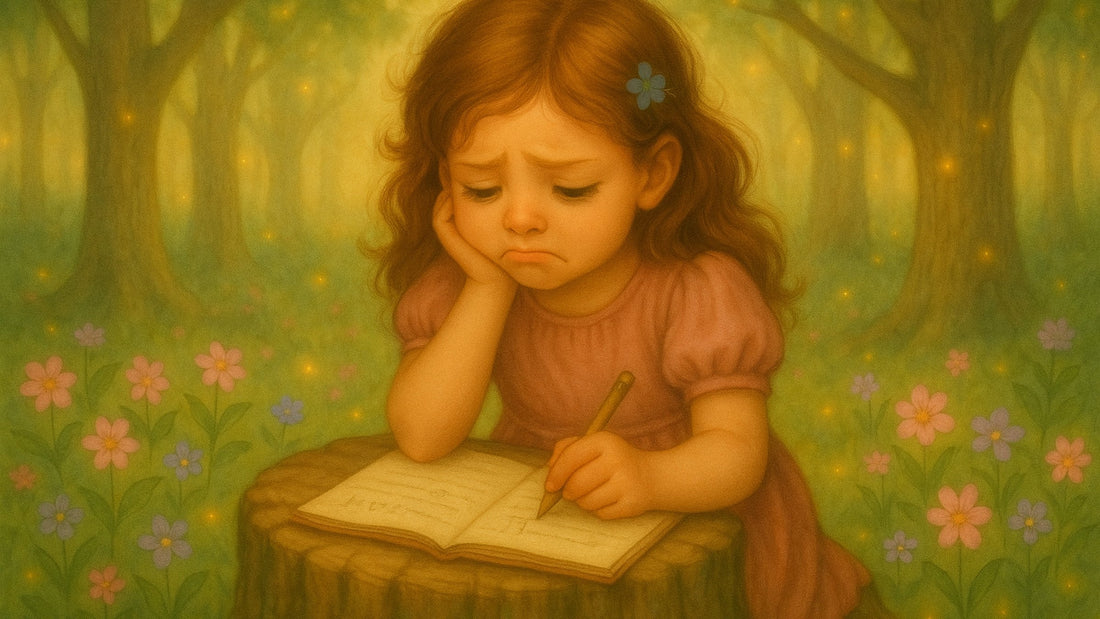
When Words Start to Wiggle: How Vision Issues Can Look Like Reading Struggles
Share
Author: Hayley Martin
What every parent should know when reading becomes a battle instead of a joy
There’s a certain heartbreak that comes when you see your child struggle with something that’s supposed to be simple, like reading a sentence, finishing a homework assignment, or following along in class.
She wants to do well. She wants to focus. She wants to love books like everyone else.
But something seems… off. She skips lines. Loses her place. Complains that the words move. Or simply avoids reading altogether.
And quietly, you begin to wonder:
Is it dyslexia?
ADHD?
A lack of focus?
Or something else entirely?
At Once Upon a Charm, we believe every child deserves to see the magic in a story, and to see it clearly. What many parents don’t realize is that reading struggles are sometimes rooted not in learning issues, but in undiagnosed vision problems that effect 1 in 4 children. And, once those eyes get the support they need? The words begin to settle, and the magic comes to life.

When the Problem Isn’t Reading, It’s Seeing
Children rarely say “I can’t see the words right” because how they see the words is normal to them. Instead, they say:
- “I hate reading.”
- “The page is blurry.”
- “The words are moving.”
- “This is too hard.”
That’s because they don’t yet know how to describe what’s happening, and because they’ve quietly adapted to seeing the world through blurry, shifting, or doubled letters.
Common Vision-Related Issues That Affect Reading:
- Eye Tracking Problems Difficulty moving smoothly from word to word or line to line
- Convergence Insufficiency The eyes don’t work together up close, causing double vision or focus fatigue
- Uncorrected Refractive Errors Blurry vision from myopia, hyperopia, or astigmatism
- Binocular Vision Dysfunction The eyes may be misaligned, leading to discomfort or confusion
- Visual Processing Issues The brain may struggle to interpret what the eyes see
These issues can make reading feel like a dizzying chore, no matter how bright, creative, or willing your child is.
Signs That Vision May Be the Root of Her Reading Struggles
Here’s a bit of everyday magic. Once you know what to look for, the signs begin to sparkle into clarity.
Watch for these common clues:
- Skips lines or re-reads the same one again
- Uses a finger to follow along (past the age it's needed)
- Loses her place easily
- Tilts her head while reading and / or writing
- Covers one eye while reading
- Complains of headaches, eye strain, or tired eyes
- Words appear to “jump,” “wiggle,” or “blur” on the page
- Avoids reading or gives up quickly, even when she wants to succeed
If your child shows any of these signs, we recommend that you schedule a comprehensive eye exam with a pediatric or developmental optometrist, so she can be tested for more subtle vision and eye teaming issues.

The Misunderstood Link Between Vision and Learning
It’s so easy to misunderstand. A child who avoids reading may look distracted. A child who reads slowly may seem like she’s behind. But the real issue may be as simple as this, her eyes are working too hard to see the words.
When vision is the hidden culprit, it can mimic:
- Dyslexia
- ADHD
- Processing disorders
- Low confidence or motivation
And while these diagnoses are real and valid for many children, they are sometimes mistakenly given when an optometrist has not checked how well the child can actually see and functionally process the page in front of her.
Helping Her See the Words, and Herself, Clearly
Once a vision issue is uncovered, the path to progress can be surprisingly magical.
The Right Glasses
Even a mild prescription can make a world of difference for a child who struggles with eye strain, double vision, or blurry text.
At Once Upon a Charm, we design glasses not just for clarity, but for confidence.
Because when your child wears something she feels beautiful in, she’s more likely to wear it consistently, embrace the change, and rediscover the joy of reading.
Our frames are:
- Lightweight and lovingly sized for little faces
- Playful with interchangeable charms, tiny fairy tokens for courage and delight
- Subtle and soft in color to let her features shine
Vision Therapy (If Recommended)
In cases of tracking or convergence problems, some optometrists recommend vision therapy, guided eye exercises that help the eyes work together more effectively. It’s like physical therapy, but for her eyes and brain. A little vision therapy can go a long way in developing your child’s ability to read with ease and comfort.

She is Not Alone. And Neither Are You.
If your daughter is struggling with reading, it doesn’t mean she’s behind. It doesn’t mean something is wrong with her. And it certainly doesn’t mean she’s not bright or capable.
It may simply mean her beautiful eyes need a little extra support.
With the right diagnosis, the right glasses, and a little encouragement, she can fall in love with stories again, the way she was always meant to.
Final Thought
Reading shouldn’t feel like a battle. If the words on the page seem to blur, bounce, or cause frustration, it might not be about her attention or her ability. It might be about her vision.
And when we support her in seeing clearly, we open a doorway. Not just to books, but to confidence, curiosity, and delight.
A diagnosed and treated vision condition will help her see the world as it truly is. Magical, clear, and full of possibility.
Explore our collection of children’s glasses and enchanting charms designed to bring stories, and little faces, to life.
